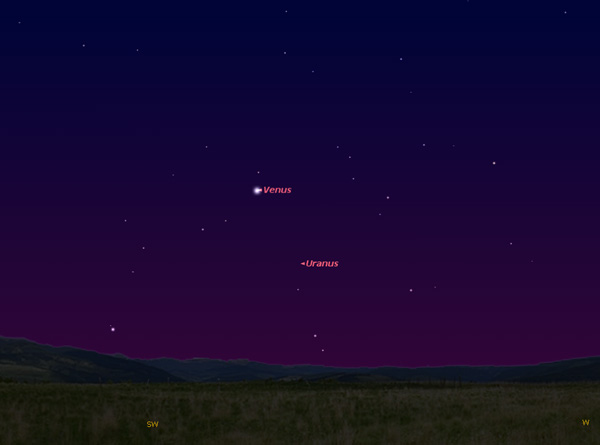| Author |
Message |
    
marken
Citizen
Username: Marken
Post Number: 94
Registered: 4-2003
| | Posted on Thursday, January 22, 2004 - 7:13 pm: | 



|
There's been a fairly bright star/planet in the southern sky recently usually between 5 and 8 pm. I think it's Venus, but we can't agree over here, so I need some reliable proof. Help!! |
    
gemini
Citizen
Username: Gemini
Post Number: 272
Registered: 6-2001
| | Posted on Thursday, January 22, 2004 - 7:17 pm: | 



|
Marken I saw it tonight, how eerily pretty. Kids thought it was the "north star" from the nativity, as it was all alone in the sky. What is it? |
    
Indi
Citizen
Username: Indi
Post Number: 13
Registered: 1-2003
| | Posted on Thursday, January 22, 2004 - 9:02 pm: | 



|
From space.com
Appearing as a brilliant white star-like object, [Venus] will set at least an hour after the Sun by the end of the first week of November. It will shine at magnitude –3.9 on the astronomers' scale. Lower numbers are reserved for the brightest objects, and Venus reigns in brightness among stars and planets. Only the Sun and Moon outshine it.
Venus slowly rises higher each evening to adorn the western evening sky all during the upcoming winter and early spring. By New Year’s Day, it will set as late as 2˝ hours after the Sun.
Venus reaches greatest elongation -- its greatest angular distance, or 46 degrees to the east of the Sun -- on March 29. From then, on into mid-April, it will be setting more than four hours after the Sun. It will be brightest in mid spring as it heads back down toward the Sun, reaching its greatest brilliancy for this apparition on May 2 at magnitude –4.5.
Venus, in fact, will be so bright at this stage of the game that it can be easily perceived with the naked eye in a deep blue, haze-free afternoon sky. That's right, during the day! After twilight ends, from a really dark site, it will be capable of casting faint, yet distinct shadows. |
    
Dave Ross
Citizen
Username: Dave
Post Number: 6179
Registered: 4-1998

| | Posted on Thursday, January 22, 2004 - 9:54 pm: | 



|
Venus 6pm
 |
    
marken
Citizen
Username: Marken
Post Number: 95
Registered: 4-2003
| | Posted on Thursday, January 22, 2004 - 10:16 pm: | 



|
Well, if it's from space.com, and on the internet, and uses lots of four syllable words then it must be true.
But seriously, thanks all ... it's good to know that I get one right once in a blue moon ... or blue venus.
|
|